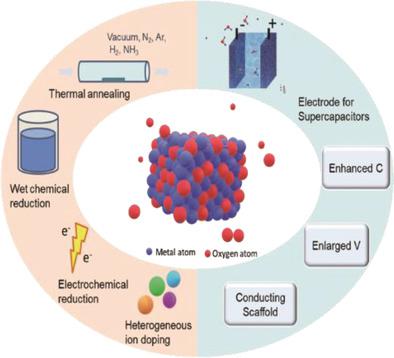当前位置:
X-MOL 学术
›
Small Methods
›
论文详情
Our official English website, www.x-mol.net, welcomes your feedback! (Note: you will need to create a separate account there.)
Oxygen Defects in Promoting the Electrochemical Performance of Metal Oxides for Supercapacitors: Recent Advances and Challenges
Small Methods ( IF 12.4 ) Pub Date : 2020-02-25 , DOI: 10.1002/smtd.201900823 Xiyue Zhang 1 , Xiaoqing Liu 1 , Yinxiang Zeng 1 , Yexiang Tong 1 , Xihong Lu 1, 2
Small Methods ( IF 12.4 ) Pub Date : 2020-02-25 , DOI: 10.1002/smtd.201900823 Xiyue Zhang 1 , Xiaoqing Liu 1 , Yinxiang Zeng 1 , Yexiang Tong 1 , Xihong Lu 1, 2
Affiliation

|
Metal oxides (MOs) with multiple active sites are regarded as one of the most potential active materials for high‐performance supercapacitor (SC) constructions. Engineering oxygen vacancies into MOs can effectively modulate their electronic properties, subtly induce impurity states in their bandgaps, and considerably optimize their electrical conductivity. Benefiting from these advantageous properties, the resultant oxygen‐defective electrodes generally embed more electrochemical active sites and present better charge storage capability in contrast to the pristine sample. Particular research attention has been given to the realization of precise oxygen vacancy introduction into MOs and the fine tuning of their properties. This review presents an overview of recent accomplishments in developing new oxygen‐defective MOs for advanced SC assembly. Different strategies for oxygen vacancy productions are summarized and compared. The specific roles of oxygen vacancies in the electrochemical performance enhancement are fully addressed and the relevant impact factors are discussed in detail. Finally, the key challenges and future opportunities in this rapidly developing field are highlighted.
中文翻译:

促进超级电容器的金属氧化物电化学性能中的氧缺陷:最新进展和挑战
具有多个活性位点的金属氧化物(MO)被认为是高性能超级电容器(SC)结构中最具潜力的活性材料之一。MO中的工程氧空位可以有效地调节其电子性能,在其带隙中巧妙地诱导杂质态,并显着优化其电导率。得益于这些优越的性能,与原始样品相比,所得的缺氧电极通常会嵌入更多的电化学活性位点,并具有更好的电荷存储能力。特别注意的是,向MO中引入精确的氧空位以及对其性质进行微调的方法已经得到了关注。这篇综述概述了在开发用于高级SC组装的新型氧缺陷型MO方面的最新成就。总结并比较了产生氧气空位的不同策略。氧空位在电化学性能增强中的具体作用已得到充分解决,并详细讨论了相关的影响因素。最后,重点介绍了这个快速发展领域中的关键挑战和未来机遇。
更新日期:2020-02-25
中文翻译:

促进超级电容器的金属氧化物电化学性能中的氧缺陷:最新进展和挑战
具有多个活性位点的金属氧化物(MO)被认为是高性能超级电容器(SC)结构中最具潜力的活性材料之一。MO中的工程氧空位可以有效地调节其电子性能,在其带隙中巧妙地诱导杂质态,并显着优化其电导率。得益于这些优越的性能,与原始样品相比,所得的缺氧电极通常会嵌入更多的电化学活性位点,并具有更好的电荷存储能力。特别注意的是,向MO中引入精确的氧空位以及对其性质进行微调的方法已经得到了关注。这篇综述概述了在开发用于高级SC组装的新型氧缺陷型MO方面的最新成就。总结并比较了产生氧气空位的不同策略。氧空位在电化学性能增强中的具体作用已得到充分解决,并详细讨论了相关的影响因素。最后,重点介绍了这个快速发展领域中的关键挑战和未来机遇。



























 京公网安备 11010802027423号
京公网安备 11010802027423号